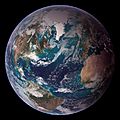Ecological footprint facts for kids
An ecological footprint measures how much people use nature's resources. It compares what we take from nature to how much nature can renew itself. Think of it like a budget: how much nature do we have, and how much do we spend?
The ecological footprint looks at how much farmland, forest, grazing land, and sea area it takes to provide everything people use. It also includes the land needed to absorb our waste, like carbon dioxide.
Right now, humanity is using nature's resources about 1.7 times faster than nature can renew them. This is like needing 1.7 planet Earths to support our current lifestyle! Since people around the world use resources differently, we can also calculate how many planets it would take if everyone lived like a certain country. For example, if everyone lived like people in Germany, we would need almost 3 planet Earths.
In terms of land area, the average person's ecological footprint is about 2.8 global hectares. But there are only 1.6 global hectares of productive land and water available per person on Earth. This means humanity is already using 70% more resources than our planet can provide. We are living unsustainably, using up nature's "capital" faster than it can grow back.
All these numbers come from a 2020 study by the Global Footprint Network, York University, and FoDaFo, using data from 2017.
Contents
What is an Ecological Footprint?
An ecological footprint is a way to measure our impact on the planet. It shows how much land and water area a person, a city, or even a country needs to produce the resources they use and absorb the waste they create. It helps us understand if we are living within Earth's limits.
Why is it Important?
Understanding our ecological footprint is important because it helps us see if we are using too many of Earth's resources. If we use more than nature can renew, we are borrowing from the future. This can lead to problems like less clean water, fewer forests, and more climate change. By knowing our footprint, we can find ways to live more sustainably.
How is it Measured?
Scientists calculate the ecological footprint by adding up all the biologically productive areas needed to support human activities. This includes:
- Cropland: For growing food, animal feed, and fibers.
- Grazing land: For raising livestock.
- Forest land: For timber, paper, and absorbing carbon dioxide.
- Fishing grounds: For seafood.
- Built-up land: For cities, roads, and buildings.
- Carbon footprint: The land needed to absorb the carbon dioxide we release from burning fossil fuels.
What Does "Overshoot" Mean?
"Overshoot" happens when humanity's ecological footprint is larger than the Earth's biocapacity. Biocapacity is the amount of resources the Earth can produce and the waste it can absorb in a given year. When we are in overshoot, it means we are using up natural resources faster than they can be replaced. It's like spending more money than you earn, leading to debt. This "ecological debt" means we are depleting natural capital, which harms future generations.
How Can We Reduce Our Footprint?
There are many ways to reduce our ecological footprint, both as individuals and as a society.
- Reduce, Reuse, Recycle: Using fewer new things, finding new uses for old items, and recycling helps save resources.
- Save Energy: Turning off lights, using energy-efficient appliances, and walking or biking instead of driving can lower our carbon footprint.
- Eat Sustainably: Choosing local foods, eating less meat, and reducing food waste can make a big difference.
- Conserve Water: Taking shorter showers and fixing leaky faucets saves precious water resources.
- Support Green Practices: Choosing products from companies that care about the environment and supporting policies that protect nature.
By making small changes in our daily lives, we can all help reduce our impact on the planet and work towards a more sustainable future.
Related pages
Images for kids
-
The natural resources of Earth are finite, and unsustainable given current levels of use.
-
Ecological footprint for different nations compared to their Human Development Index
See also
 In Spanish: Huella ecológica para niños
In Spanish: Huella ecológica para niños





